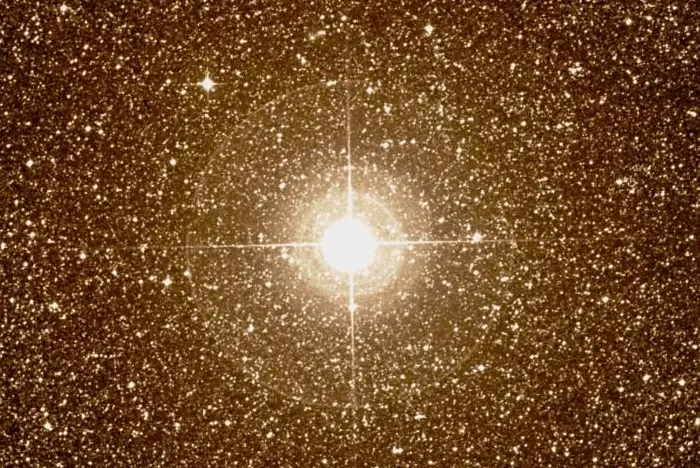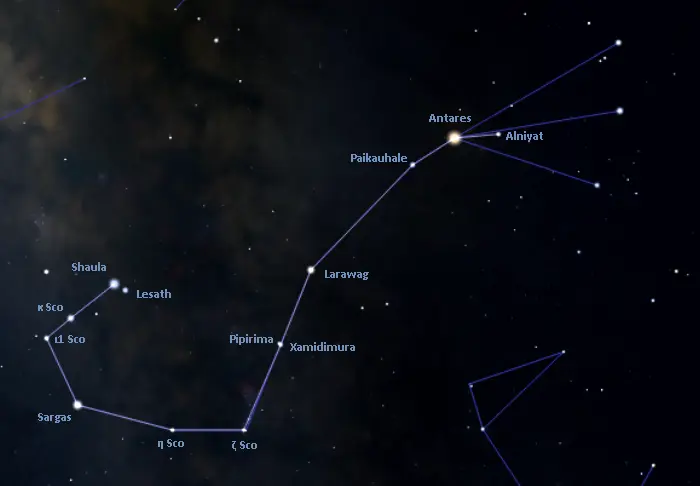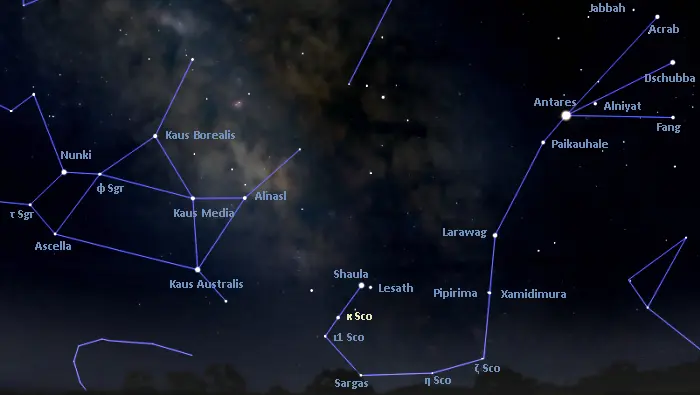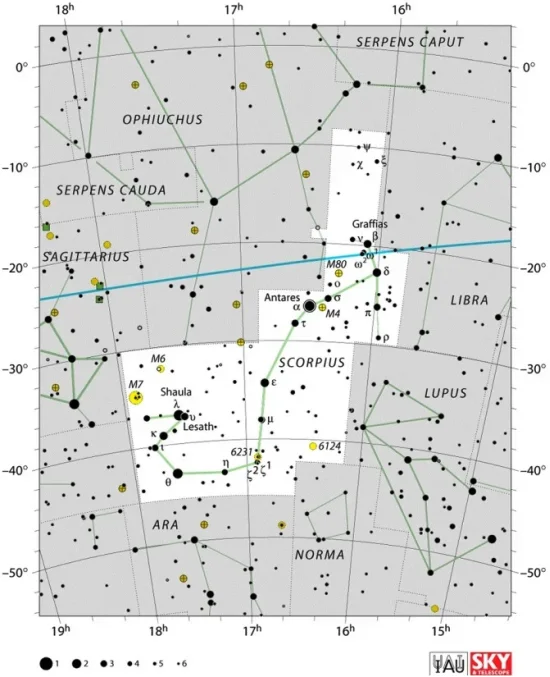Kappa Scorpii (κ Sco) is a spectroscopic binary star system located approximately 480 light-years away in the zodiac constellation Scorpius. With an apparent magnitude 2.41 – 2.42, it is the sixth brightest star in Scorpius. Traditionally known as Girtab, the double star appears in the Scorpion’s tail. Kappa Scorpii is one of the bright stars that form the Fish Hook, a prominent asterism that is part of the constellation figure of Scorpius.
Star system
Kappa Scorpii is a massive spectroscopic binary star with the stellar classification B1.5 III, indicating a blue giant star. The two components of the system are very close together and have an orbital period of 196 days. They are separated by about 1.7 astronomical units (Earth – Sun distances). The stars have an eccentric orbit that brings them within 0.87 AU of each other and takes them as far apart as 2.5 AU.
The primary component, Kappa Scorpii A, has a mass 17 times that of the Sun and a radius 6.8 times solar. With an effective temperature of 23,400 K, it is 6,911 times more luminous than the Sun. The star is a fast spinner. With a projected rotational velocity of 105 km/s, it takes 1.90 days to complete a rotation. The giant star has an estimated age of 25.1 million years.

Girtab (Kappa Scorpii), image: Wikisky (DSS2)
Kappa Scorpii A is classified as a Beta Cephei variable. Its brightness varies with a period of 4.8 hours due to pulsations. Many other bright stars belong to this class, including Shaula (Lambda Scorpii), Alniyat (Sigma Scorpii), Spica (Alpha Virginis), Hadar (Beta Centauri), Epsilon Centauri, Imai (Delta Crucis), Alpha Lupi, Eta Orionis, Alpha Muscae, Algenib (Gamma Pegasi), and the class prototypes Alfirk (Beta Cephei) and Mirzam (Beta Canis Majoris).
The secondary star, Kappa Scorpii B, has 12 times the Sun’s mass and a radius 5.8 times that of the Sun. It has a surface temperature of 18,800 K.
Facts
Girtab is the sixth brightest star in Scorpius, after Antares, Shaula, Sargas, Dschubba, and Larawag. It is on average the 83rd brightest star in the sky. It is about as bright as Enif, the brightest star in Pegasus.
Kappa Scorpii forms the Fish Hook of Scorpius with Antares (Alpha Scorpii), Alniyat (Sigma Scorpii), Paikauhale (Tau Scorpii), Larawag (Epsilon Scorpii), Pipirima (Mu2 Scorpii), Xamidimura (Mu1 Scorpii), Zeta Scorpii, Eta Scorpii, Sargas (Theta Scorpii), Iota1 Scorpii, and Shaula (Lambda Scorpii). The asterism makes the constellation Scorpius easily recognizable. In the constellation figure of the Scorpion, Antares marks the heart, Alniyat and Paikauhale the arteries, Shaula the stinger, and the remaining stars the body and tail.

The stars of the Fish Hook, image: Stellarium
Kappa Scorpii is one of the 27 stars featured on the flag of Brazil. Each star is associated with a Brazilian state and Girtab represents the state of Paraíba. Several other bright Scorpius stars appear on the Brazilian flag: Antares, Shaula, Sargas, Larawag, Acrab, Iota Scorpii, and Mu Scorpii (Pipirima and Xamidimura).
Name
Kappa Scorpii does not have a name formally approved by the International Astronomical Union (IAU). It was historically known as Girtab (pronunciation: /ˈɡɜːrtæb/). The name comes from the Sumerian word for “scorpion.” It originally denoted an asterism formed by Kappa Scorpii with Shaula (Lambda Scorpii), Lesath (Upsilon Scorpii), and Iota Scorpii.
Kappa Scorpii is one of the brightest stars without a formal proper name, along with the brighter Gamma Velorum, Gamma Cassiopeiae, Gamma Centauri, Epsilon Centauri, Eta Centauri, and Alpha Lupi.
In Chinese astronomy, Girtab was known as 尾宿七 (Wěi Xiù qī), the Seventh Star of Tail. The Tail was an asterism formed by Girtab with Xamidimura (Mu1 Scorpii), Larawag (Epsilon Scorpii), Zeta1 Scorpii, Zeta2 Scorpii, Eta Scorpii, Sargas (Theta Scorpii), Iota1 Scorpii, Iota2 Scorpii, Shaula (Lambda Scorpii), and Lesath (Upsilon Scorpii). The asterism was part of the larger Tail mansion, which represented the tail of the Azure Dragon.
Location
Kappa Scorpii is easy to find because it is part of the Fish Hook, an asterism easily visible even from light-polluted areas. Girtab appears near the brighter Shaula, which marks the Scorpion’s stinger with the fainter Lesath.
At declination -39°, Girtab is visible from locations south of the latitude 51° N. It never rises very high above the southern horizon for observers in the mid-northern latitudes. Like other Scorpius stars, it is best seen from the southern hemisphere.

The location of Girtab (Kappa Scorpii), image: Stellarium
Constellation
Girtab is located in the southern constellation of Scorpius. The celestial Scorpion is one of the Greek constellations, catalogued by Claudius Ptolemy of Alexandria in his Almagest in the 2nd century CE. Occupying 497 square degrees of the southern sky, Scorpius is the 33rd constellation in size. With 13 stars brighter than magnitude 3.0, it is one of the brightest constellations in the sky. In Greek mythology, it is linked with the scorpion that stung the giant huntsman Orion.
Scorpius is home to Antares (Alpha Scorpii), the 15th brightest star in the sky. The variable red supergiant shines at magnitude of 0.6 – 1.6 from an approximate distance of 550 light-years.
Shaula and Sargas (Lambda and Theta Scorpii), the second and third brightest stars in Scorpius, are the 24th and 39th brightest stars in the sky. Shaula is a variable hot blue subgiant in a triple star system located around 570 light-years away, and Sargas is a yellow-white bright giant with a fainter companion, located approximately 329 light-years away.

Scorpius constellation map by IAU and Sky&Telescope magazine
Other notable stars in Scorpius include the hot blue B-type subgiants Dschubba (Delta Scorpii) and Lesath (Upsilon Scorpii), the orange giants Larawag (Epsilon Scorpii) and Fuyue (G Scorpii), the blue giant Alniyat (Sigma Scorpii), the massive B-type main sequence stars Acrab (Beta Scorpii), Paikauhale (Tau Scorpii) and Pi Scorpii, the F-type supergiant Iota1 Scorpii, the luminous blue variable Zeta1 Scorpii, and the recurrent nova U Scorpii.
Scorpius also contains the candidate luminous blue variable Wray 17-96, one of the most luminous stars known, the red supergiant AH Scorpii, one of the largest stars known, the yellow hypergiant IRAS 17163−3907, and the massive star system Pismis 24-1, the brightest member of the open cluster Pismis 24 within the larger Lobster Nebula (NGC 6357).
Bright deep sky objects in Scorpius include the open clusters Messier 6 and Messier 7 (the Butterfly Cluster and the Ptolemy Cluster), the Northern Jewel Box Cluster (NGC 6231) and NGC 6281, the globular clusters Messier 4 and Messier 80, the reflection nebula IC 4592 (the Blue Horsehead Nebula), the protoplanetary Cotton Candy Nebula, the bipolar planetary Butterfly Nebula (NGC 6302), and the emission nebulae IC 4628 (the Prawn Nebula), NGC 6334 (the Cat’s Paw Nebula) and NGC 6357 (the Lobster Nebula or War and Peace Nebula).
The stars and deep sky objects in Scorpius are best seen in the month of July, when the celestial Scorpion appears higher above the horizon in the early evening. The entire constellation is visible from locations south of the latitude 40° N.
The 10 brightest stars in Scorpius are Antares (Alpha Sco A, mag. 0.6 – 1.6), Shaula (Lambda Sco A, mag. 1.62), Sargas (Theta Sco A, mag. 1.84), Dschubba (Delta Sco, mag 2.307), Larawag (Epsilon Sco, mag. 2.31), Kappa Sco (mag. 2.39), Acrab (Beta Sco, mag. 2.62), Lesath (Upsilon Sco, mag. 2.70), Paikauhale (Tau Sco, mag. 2.82), and Fang (Pi Sco, mag. 2.89).
Kappa Scorpii
| Spectral class | B1.5 III |
| Variable type | Beta Cephei |
| U-B colour index | -0.914 |
| B-V colour index | -0.228 |
| Apparent magnitude | 2.41 – 2.42 |
| Absolute magnitude | −3.46 |
| Distance | 480 ± 10 light-years (148 ± 4 parsecs) |
| Parallax | 6.75 ± 0.17 mas |
| Radial velocity | -14.0 ± 2.8 km/s |
| Proper motion | RA: −6.05 ± 0.21 mas/yr |
| Dec.: −25.54 ± 0.13 mas/yr | |
| Constellation | Scorpius |
| Right ascension | 17h 42m 29.27520s |
| Declination | −39° 01′ 47.9391″ |
| Names and designations | Girtab, Kappa Scorpii, κ Scorpii, κ Sco, HD 160578, HR 6580, HIP 86670, SAO 209163, FK5 660, PPM 296701, CD−38°12137, CPD−38°6992, CPC 18 8904, ALS 15051, CEL 4553, GC 23988, GCRV 10217, EUVE J1742-39.0, GSC 07885-02065, JP11 2875, TIC 147868882, UBV M 22326, UBV 15027, IRAS 17389-3900, 2MASS J17422928-3901479, PMC 90-93 469, TYC 7885-2065-1, Gaia DR3 5961206940987571200 |
Kappa Scorpii A
| Mass | 17 M☉ |
| Luminosity | 6,911 L☉ |
| Radius | 6.8 R☉ |
| Temperature | 23,400 K |
| Age | 25.1 ± 1.3 million years |
| Rotational velocity | 105 km/s |
| Rotation | 1.90 days |
| Surface gravity | 4.01 cgs |
Kappa Scorpii B
| Mass | 12 M☉ |
| Radius | 5.8 R☉ |
| Temperature | 18,800 K |
| Surface gravity | 4.00 cgs |